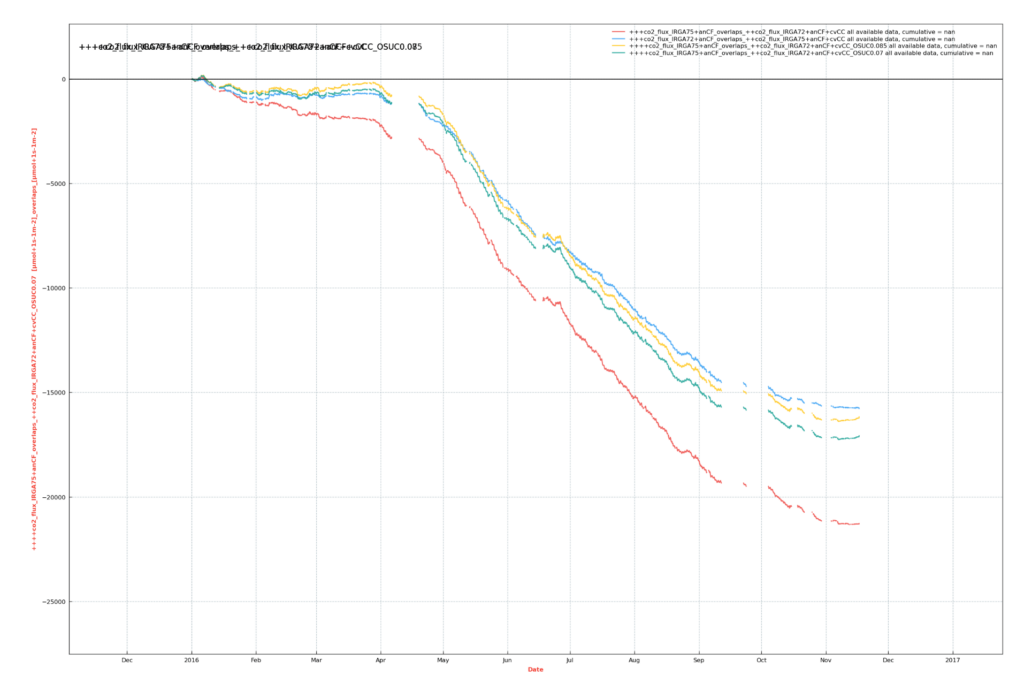Flux Processing Meeting #2 for FF-202101
Meeting date: 3 Mar 2021, 10h
Participants: ***
Goal of FF-202101
- Goal 1: Final fluxes (FF) for selected site years
- Goal 2: Final flux product (FP) for all FFs
Purpose of this meeting
- Fluxes for multiple site years are currently updated or newly calculated, started in January 2021.
- This is the second meeting to identify required site years and to agree on the processing schedule.
Goals of this meeting
- Give overview of upcoming processing steps for SRPs
- Give update on current processing status
- Discuss further steps for upcoming processing
- Identify what needs to be processed or updated
Notes
- Please make sure to check data you are working with. Check if anything looks unusual or not as you expected, cross-check when possible.
- An overview of the current processing for FF-202101 can be found online in Google Docs here.
- FF-202101 includes 40+ site years. Note that each gas analyzer counts separately due to separate processing, e.g. CH-CHA has IRGA75 and QCL fluxes for 2020 (counts as 2 years).
- Some site years will be uploaded to FLUXNET, ideally by the end of March 2021. Check below which sites.
- Nearly all calculations are done on the RDSnx (virtual computers).
- Multiple calculations were stopped due to problems with server access from the RDSnx
- Recent calculations worked well without problems
- It seems that calculations work better when the scratch drive E on the RDSnx is used
- E is a temporary storage space
- E is deleted once a month during maintenance, check the RDSnx desktop wallpaper for maintenance dates and make sure to move your results away from E to another space before they are deleted
Calculation priorities
Priority 1
- CH-INO: CH-AES 2019-2020, CH-DAE 2019, CH-OE2 2018-2020 [for PhD RM] –> using dynamic vegetation height
- shared in FLUXNET: none
- CH-OE2: 2020 (IRGA72) [for PhD RM] –> using dynamic vegetation height
- shared in FLUXNET: CH-OE2 2020 IRGA72
- CH-CHA: 2019 (QCL) and 2020 (QCL+IRGA75) [for PhD IF] –> using dynamic vegetation height
- shared in FLUXNET: CH-CHA 2020 IRGA75
- CH-DAV: IRGA72
- shared in FLUXNET: CH-DAV 2020 IRGA72
Priority 2
- CH-CHA: 2016-2018 (QCL) [for PhD IF]
- shared in FLUXNET: none
Priority 3
- CH-AWS: 2020 (IRGA72) needs meteo screening
- shared in FLUXNET: CH-AWS 2020
- CH-FRU: 2020 (IRGA72) needs meteo screening
- shared in FLUXNET: CH-FRU 2020
- CH-LAE: 2020 (IRGA72) needs meteo screening?
- shared in FLUXNET: CH-LAE 2020
- CH-DAV: 1997-2005 (IRGA62) H2O correction from NABEL reference
- shared in FLUXNET: CH-DAV 1997-2005
Priority 4
- CH-LAS: 2014-2020 (IRGA75) possible that 2014-2018 are already final, check [for PhD AS]
- shared in FLUXNET: none?
- CH-LAE: parallel measurements: IRGA75 2017, IRGA72 2016 both still todo [for PhD AS]
- shared in FLUXNET: IRGA75 fluxes should be updated with IRGA72 fluxes where possible
Later
- CH-DAV QCL
Other
- What about Burba off-season uptake correction for older years? Use parallel measurements from sites also for other sites as basis for correction?
- The correction can be done quickly after Level-1 fluxes were calculated, this is a short processing step.
- But it is currently up for discussion how to best perform this correction.
- See Figure below how this correction affected CH-DAV 2016 CO2 fluxes.

Effect of off-season uptake correction on cumulative CO2 fluxes (no gap-filling) at CH-DAV 2016. BLUE: IRGA72 fluxes (reference), RED: IRGA75 fluxes without correction, GREEN: IRGA75 fluxes with 7% correction, YELLOW: IRGA75 fluxes with 8.5% correction.
Time schedule
- Level-1 flux calculations staretd in Jan 2021
Tools
METSCR: ETH Meteoscreening tool for meteo data checkBICO: Conversion of binary raw data to csv files | linkDYCO: Improved lag detection for low fluxes fluxesFLUXRUN: Flux calculations Level-1, using EddyPro | linkAMP: Quality control of fluxes, Creation of Level-2REDDYPROC: ustar filtering and gap-filling
Processing Steps
METSCRMeteoscreeningBICOConversion of binary raw data files to ASCII files (CSV)FLUXRUNOPENLAG flux processing with relaxed processing settings, identifies issues and checks correct lag time and wind directions, can be done without screened meteo dataDYCOPreparation of CSV files for final flux calculations: detect and remove lags and lag time jumps, for QCL and LGR only and only if CO2 is available on the laser gas analyzer.
FLUXRUNProduction of Level-1 fluxes, calculations with final processing settings and screened meteo data- CORRECTIONS: might be necessary, e.g. IRGA75 vs IRGA72 fluxes comparison for Burba correction
AMPProduction of Level-2 fluxes (full QC), removal of low quality fluxes, removal of outliers, preparation for next stepREDDYPROCProduction of Level-3 and Level-4 fluxes: ustar filtering, gap-filling and partitioning
More info
- Info about flux levels
- Currently available flux products
- Example for post-processing to create a finished flux product (FP): CH-DAV FP2020 (1997-2019)
Last Updated on 18 Feb 2024 22:12
